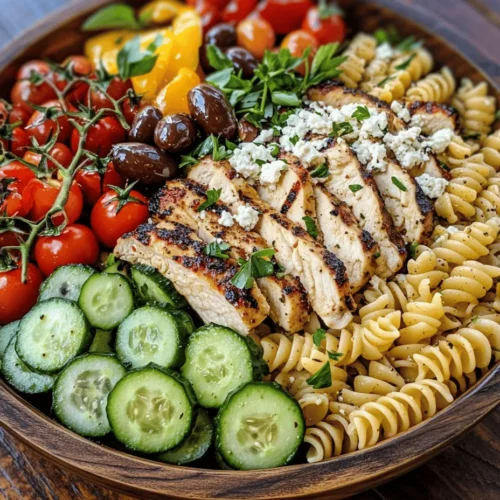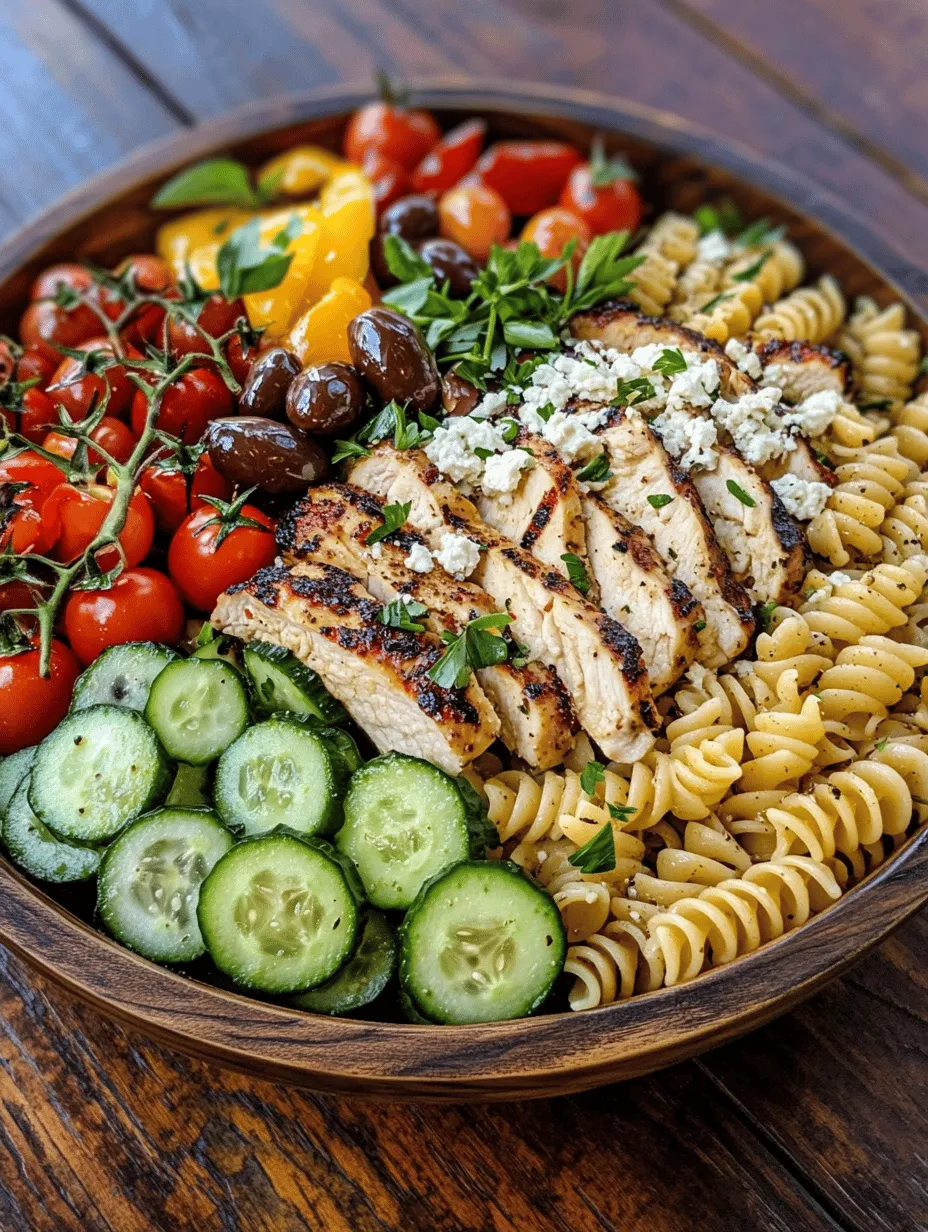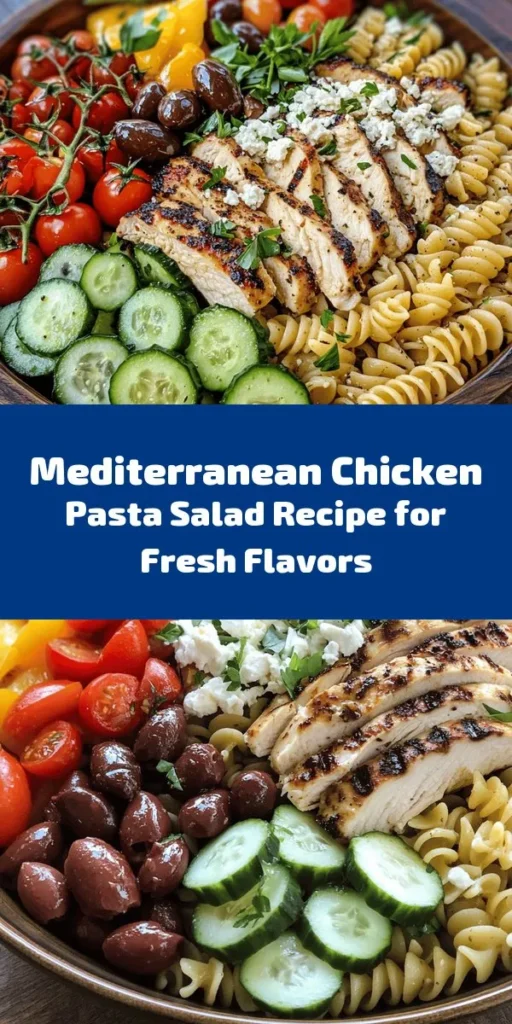Introduction
Mediterranean cuisine is renowned not only for its vibrant flavors but also for its emphasis on health and wellness. Characterized by the use of fresh ingredients, healthy fats, and a balanced approach to meals, this culinary tradition has gained immense popularity worldwide. The Mediterranean diet is often associated with numerous health benefits, including reduced risk of heart disease, improved metabolic health, and enhanced longevity. At the heart of this cuisine lies a variety of ingredients such as whole grains, lean proteins, fresh produce, and healthy fats, which together create a wholesome dining experience.
One delightful dish that encapsulates the essence of Mediterranean cooking is the Mediterranean Chicken Pasta Salad. This refreshing and nutritious salad is perfect for any occasion—whether you’re hosting a summer barbecue, packing lunch for work, or simply seeking a light and flavorful dinner. It combines tender chicken, colorful vegetables, and al dente pasta, making it a balanced meal that is as satisfying as it is delicious. Not only does it offer a burst of flavors, but it also provides essential nutrients from a variety of food groups, ensuring that you leave the table feeling energized and nourished.
Understanding the Ingredients
To create a standout Mediterranean Chicken Pasta Salad, it’s essential to understand the key components that contribute to its flavor and nutritional profile. Each ingredient plays a vital role in delivering a satisfying and well-rounded dish.
Pasta: Types and Their Role in the Dish
Pasta serves as the foundation of this salad, providing the necessary carbohydrates to fuel your body. When selecting pasta for this dish, you have several options, each bringing its own unique texture and flavor. Popular choices include penne, rotini, and fusilli, which are excellent for holding onto the dressing and other ingredients. Whole wheat or gluten-free pasta are great alternatives for those seeking healthier or specialized options. The key is to choose a shape that will complement the overall presentation and ensure that each bite is filled with flavor.
Chicken: Nutritional Benefits and Cooking Methods
Chicken is the star of this salad, providing a lean source of protein that is both filling and nutritious. It contributes essential amino acids that support muscle health and overall bodily function. When preparing the chicken for this dish, grilling or baking are preferred methods that allow for a juicy and flavorful result without excess fat. Seasoning the chicken with Mediterranean spices such as garlic, oregano, and lemon zest can elevate its taste and enhance the dish’s authenticity.
Fresh Vegetables: Importance of Variety and Color
Incorporating a variety of fresh vegetables not only adds visual appeal but also boosts the nutritional value of the salad. Colorful vegetables such as bell peppers, cherry tomatoes, cucumbers, and red onions provide a range of vitamins, minerals, and antioxidants. Each vegetable brings its own unique flavor and texture, creating a delightful contrast in every bite. When selecting vegetables, consider choosing those that are in season for maximum freshness and flavor.
Olives and Feta: Adding Flavor and Healthy Fats
No Mediterranean dish would be complete without the inclusion of olives and feta cheese. Both ingredients add richness and depth of flavor while also introducing healthy fats into the salad. Olives, particularly Kalamata or green olives, provide a briny taste that complements the other ingredients beautifully. Feta cheese, crumbly and tangy, adds a creamy element that ties the dish together. In addition to their flavor, both olives and feta contribute valuable nutrients, including heart-healthy monounsaturated fats and calcium.
Herbs: Enhancing Taste and Health Benefits
Fresh herbs are the finishing touch that elevates the Mediterranean Chicken Pasta Salad to new heights. Herbs like parsley, basil, and mint not only add vibrant flavors but also come packed with health benefits. Parsley is rich in vitamins A, C, and K, while basil contains anti-inflammatory properties. Mint adds a refreshing note that balances the richness of the chicken and feta. When using herbs, opt for fresh whenever possible to ensure the best flavor and aroma.
Step-by-Step Preparation
Now that we’ve explored the essential ingredients, let’s dive into the step-by-step preparation of the Mediterranean Chicken Pasta Salad. This section outlines how to cook the pasta, prepare the chicken, and mix the vegetables to create a delicious and colorful dish.
Cooking the Pasta
The first step in preparing the Mediterranean Chicken Pasta Salad is cooking the pasta. Follow these guidelines to ensure perfectly cooked pasta:
1. Choose Your Pasta: Select your preferred type of pasta, considering shapes that hold dressing well, such as penne or fusilli.
2. Bring Water to a Boil: In a large pot, bring salted water to a rolling boil. The salt enhances the flavor of the pasta as it cooks.
3. Add the Pasta: Once the water is boiling, add the pasta and stir to prevent sticking. Follow the package instructions for cooking time, usually around 8-12 minutes, depending on the type.
4. Aim for Al Dente: For a salad, it’s crucial to cook the pasta al dente—firm to the bite. This texture helps it maintain its shape and prevents it from becoming mushy when mixed with other ingredients.
5. Drain and Cool: After cooking, drain the pasta in a colander and rinse it under cold water to stop the cooking process. This step cools the pasta quickly, making it ready to be combined with the salad ingredients.
Preparing the Chicken
While the pasta is cooking, you can prepare the chicken. Here’s how to ensure juicy, flavorful chicken for your salad:
1. Choose the Right Cut: Boneless, skinless chicken breasts or thighs work well for this recipe. Thighs tend to be juicier, while breasts are leaner.
2. Season Generously: Season the chicken with olive oil, salt, pepper, and your choice of Mediterranean spices. Garlic powder, dried oregano, and lemon juice make excellent flavor enhancers.
3. Cooking Techniques:
– Grilling: Preheat the grill to medium-high heat. Place the chicken on the grill and cook for about 6-8 minutes per side, or until the internal temperature reaches 165°F (75°C).
– Baking: Preheat the oven to 375°F (190°C). Place the seasoned chicken on a baking sheet and bake for 25-30 minutes, or until cooked through.
4. Check for Doneness: Use a meat thermometer to ensure the chicken is properly cooked. This step is crucial for food safety.
5. Let it Rest: Once the chicken is cooked, remove it from the heat and let it rest for 5-10 minutes. This allows the juices to redistribute, resulting in a juicier chicken.
Mixing the Vegetables
With the pasta cooked and the chicken prepared, it’s time to mix in the fresh vegetables. Follow these tips for selecting and preparing your veggies:
1. Choose Fresh Vegetables: Opt for seasonal and locally sourced produce whenever possible. Look for vibrant colors and firm textures for the best flavor.
2. Washing and Drying: Rinse all vegetables thoroughly under cold water to remove any dirt or pesticides. Pat them dry with a clean towel.
3. Cutting Techniques:
– Chop: Dice bell peppers, cucumbers, and red onions into bite-sized pieces for easy mixing and eating.
– Halve: Slice cherry tomatoes in half to reveal their juicy interiors, allowing them to blend seamlessly with the other ingredients.
– Slice: For cucumbers and onions, thinly slice to enhance their crunch and flavor distribution throughout the salad.
4. Mixing the Ingredients: In a large mixing bowl, combine the cooled pasta, chopped chicken, and freshly cut vegetables. Toss gently to ensure even distribution of flavors.
By following these steps, you’ll be well on your way to creating a delicious Mediterranean Chicken Pasta Salad that brings a taste of the Mediterranean right to your table. With its vibrant colors, fresh ingredients, and satisfying taste, this salad is sure to impress your family and friends, making it a go-to dish for any occasion.

Combining Ingredients
Once you’ve cooked your pasta and prepared your vegetables, it’s time to bring everything together for your Mediterranean Chicken Pasta Salad. This step is crucial because the way you combine your ingredients can affect the texture and overall enjoyment of the dish.
How to Gently Mix Ingredients Without Bruising Vegetables
To maintain the integrity of your fresh vegetables, it’s essential to mix the salad gently. Start by placing the cooked pasta in a large mixing bowl. Allow it to cool slightly if it’s still warm; this prevents wilting the vegetables. Next, add the diced chicken, cherry tomatoes, diced cucumbers, red onion, bell peppers, and olives.
Using a large spatula or wooden spoon, fold the ingredients together carefully. Start from the bottom and lift the mixture rather than stirring aggressively, which can bruise the vegetables and make them mushy. Aim for a well-distributed mixture where every bite of pasta salad contains a bit of everything.
Importance of Balancing Flavors in the Salad
When you’re creating a Mediterranean Chicken Pasta Salad, balancing flavors is key to achieving a delicious dish. The salad should have a combination of savory, tangy, and fresh flavors.
– Savory: The grilled chicken provides a hearty and savory base.
– Tangy: The addition of feta cheese and olives adds a briny, tangy bite.
– Fresh: Fresh vegetables like cucumbers and tomatoes bring a bright freshness that complements the richness of the chicken and dressing.
Taste your salad as you mix and adjust accordingly. If you find it needs a bit more acidity, consider adding a splash of lemon juice. If it feels too bland, a pinch of salt or a dash of pepper can elevate the flavors.
Dressing the Salad
Choosing the right dressing for your Mediterranean Chicken Pasta Salad can enhance the overall flavor profile. A good dressing should complement the ingredients without overpowering them.
How to Choose the Right Dressing for Mediterranean Flavors
Traditional Mediterranean dressings often feature olive oil, lemon juice, garlic, and herbs. For your salad, you can whip up a simple dressing by whisking together:
– 1/4 cup extra virgin olive oil
– 2 tablespoons lemon juice
– 1 clove minced garlic
– 1 teaspoon dried oregano
– Salt and pepper to taste
This combination will add richness and a refreshing zing to your salad, perfectly aligning with the Mediterranean theme.
Tips for Achieving the Perfect Coating Without Over-Dressing
To avoid over-dressing your salad, drizzle the dressing over the mixture rather than pouring it all at once. Start with about half the dressing and gently toss the salad. Then, taste it again. If it needs more flavor, gradually add more dressing until you reach your desired taste. This method ensures that the pasta and vegetables are evenly coated without becoming soggy.
Serving Suggestions
Serving your Mediterranean Chicken Pasta Salad well can elevate your dining experience.
Ideal Serving Temperature and Presentation Tips
This salad is best served chilled or at room temperature, making it a versatile choice for various occasions. For presentation, consider serving it in a large, beautiful bowl, garnished with a sprinkle of fresh parsley or additional feta cheese on top.
Pairing with Other Mediterranean Dishes
This salad pairs wonderfully with other Mediterranean dishes. Consider serving it alongside:
– Grilled vegetable skewers
– Hummus and pita bread
– Tzatziki sauce for dipping
– A bowl of tabbouleh or couscous salad
These complementary dishes will create a well-rounded Mediterranean feast.
Suggestions for Suitable Occasions
Mediterranean Chicken Pasta Salad is ideal for several occasions, including:
– Picnics: It’s easy to transport and can be enjoyed cold.
– Potlucks: A crowd-pleaser that allows for easy serving and sharing.
– Meal Prep: Keeps well in the refrigerator for a few days, making it perfect for weeknight dinners or lunch.
Nutritional Benefits
This Mediterranean Chicken Pasta Salad is not only delicious but also packed with nutrition.
Analysis of the Health Benefits of Each Ingredient
– High Protein from Chicken: Chicken breast is a lean protein source, essential for muscle repair and growth.
– Fiber and Vitamins from Vegetables: The inclusion of vegetables like cucumbers, bell peppers, and tomatoes offers dietary fiber, which aids digestion, and vitamins A and C, which support overall health.
– Healthy Fats from Olives and Feta: Olives provide monounsaturated fats, which are heart-healthy, while feta cheese adds calcium and protein.
Overview of Calorie Count and Portion Sizes
A typical serving of Mediterranean Chicken Pasta Salad (about 1 cup) can range from 300 to 400 calories, depending on the amount of dressing and cheese used. Adjust portion sizes based on your dietary needs and preferences, keeping in mind the balance of protein, carbohydrates, and fats.
Customization Ideas
One of the best aspects of Mediterranean Chicken Pasta Salad is its versatility. You can easily customize it to suit your dietary needs or personal tastes.
Suggestions for Ingredient Substitutions
– Vegetarian Options: Substitute grilled chicken with chickpeas or roasted vegetables like zucchini and eggplant for a vegetarian version.
– Gluten-Free Pasta: Use gluten-free pasta options, such as quinoa pasta or spiralized vegetables, to create a gluten-free salad.
Variations on the Dressing to Suit Personal Tastes
Feel free to experiment with different dressings. For a creamier option, you can mix Greek yogurt with the olive oil and lemon juice. Alternatively, adding a bit of balsamic vinegar can give it a sweet tang that pairs nicely with the other ingredients.
Add-Ins for Extra Nutrition
To boost the nutritional content, consider adding:
– Nuts: Sliced almonds or walnuts can add crunch and healthy fats.
– Seeds: Chia or sunflower seeds enhance the salad’s texture and provide additional vitamins and minerals.
– Beans: Adding a can of drained and rinsed cannellini beans can increase the fiber and protein content, making the salad more filling.
Conclusion
In summary, the Mediterranean Chicken Pasta Salad is a delightful dish that combines vibrant flavors, nutritious ingredients, and endless customization options. Its versatility makes it suitable for various occasions—from casual picnics to sophisticated dinner parties.
Encouraging readers to experiment with their variations, whether through different dressings or ingredient substitutions, can create a personalized touch to this classic recipe. Ultimately, enjoying fresh, homemade meals not only satisfies the appetite but also promotes overall well-being. Dive into this Mediterranean delight today and discover how easy it is to embrace the flavors of the Mediterranean in your own kitchen.



